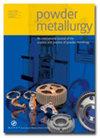低能铣削工艺对铁镍钴软磁材料磁性能的影响
IF 1.9
4区 材料科学
Q2 METALLURGY & METALLURGICAL ENGINEERING
引用次数: 0
摘要
本文报道了低能量球磨获得的软磁材料的微应变效应。已经观察到,球磨的低能量改变了磁畴尺寸,增加了作为铁磁颗粒的球磨粉末的磁化率、剩磁和磁导率。这是由于线性缺陷的增加和晶格应变的增加。由于通过研磨获得的结晶缺陷上的磁化线之间的空隙连接,磁化率MS随着颗粒尺寸的减小而减小,但由于结晶缺陷的累积,磁化率M S增加了高达70%。这种响应是通过球磨的冷加工产生的。本文章由计算机程序翻译,如有差异,请以英文原文为准。
Effect of low energy milling processes on the magnetic properties of Fe–Ni–Co soft magnetic materials
ABSTRACT This work reports the effect of micro strain of soft magnetic materials obtained by low-energy ball milling. It has been observed that the low energy of the ball milling changes the magnetic domain size, increasing magnetisation, remanence and magnetic permeability of the milled powders as ferromagnetic particles. It is due to the increase of linear defects and the increase of lattice strain. The magnetisation M S increases up to 70% by the accumulation of crystalline defects, although M S decreases with the reduction of particle size, due to the connections of voids between the lines of magnetisation across the crystalline defects obtained by milling. This response is produced by the cold working through the ball milling.
求助全文
通过发布文献求助,成功后即可免费获取论文全文。
去求助
来源期刊

Powder Metallurgy
工程技术-冶金工程
CiteScore
2.90
自引率
7.10%
发文量
30
审稿时长
3 months
期刊介绍:
Powder Metallurgy is an international journal publishing peer-reviewed original research on the science and practice of powder metallurgy and particulate technology. Coverage includes metallic particulate materials, PM tool materials, hard materials, composites, and novel powder based materials.
 求助内容:
求助内容: 应助结果提醒方式:
应助结果提醒方式:


